Biology
Biology concepts ? common descent, evolution, direct descent, fungi, undulipodia, amphibians, phylogenetics
Bacteria were, and are, just about perfect organisms. They were bacteria then, and they are bacteria now - why mess with perfection. They have diverged into many types of bacteria, and those types are diverging even today, but they have stayed as bacteria.
Scientists use changes in DNA over time to track just when two lines of organisms diverged from their last common ancestor. They can plot this out by time and distance, forming a diagram. This is the study of phylogeny (from Greek phylos = race, and genesis = birth of) and its tools are phylogenetics. Because the diagrams can look like trees, with the common ancestor as the base of the trunk, they are called phylogenetic trees.
The archaea that diverged to become eukaryotes lost their flagella at some point, and then very quickly evolved them right back again. The structure of the new flagella were different; made from different proteins and having a different structure, but they did about the same job(s). This re-evolving of a flagellum (and cilium) must have occurred pretty quickly, because all the kingdoms that descended from those early eukaryotes (protists, plants, fungi, animals) have them to some degree or another.
You could do the genetics studies to find out which phylum diverged first, and then which one diverged from that and so on, but it would be a waste of time ? it?s already been done. The picture to the right shows the phylogenetic tree for four of the phyla of fungi (minus the bothersome imperfect fungi).
B. dendrobatidis, on the other hand, is the only known chytrid parasite of living animals - amphibians specifically. The fungi embed themselves in the keratinized skin of amphibians that find themselves in chytrid-contaminated water and then proceed to digest their skin. As many as 6000 species may be vulnerable to this fungus, and several hundred have gone extinct because of it.
Martel, A., Spitzen-van der Sluijs, A., Blooi, M., Bert, W., Ducatelle, R., Fisher, M., Woeltjes, A., Bosman, W., Chiers, K., Bossuyt, F., & Pasmans, F. (2013). Batrachochytrium salamandrivorans sp. nov. causes lethal chytridiomycosis in amphibians Proceedings of the National Academy of Sciences, 110 (38), 15325-15329 DOI: 10.1073/pnas.1307356110
Buck, J., Truong, L., & Blaustein, A. (2011). Predation by zooplankton on Batrachochytrium dendrobatidis: biological control of the deadly amphibian chytrid fungus? Biodiversity and Conservation, 20 (14), 3549-3553 DOI: 10.1007/s10531-011-0147-4
- Unifying Themes In Biology
this will be built on heavily as posting progresses. These unifying ideas should help to make it so that the interconnectivity of biology is clearer, so while learning, questions like "what is this all for/why is it important?" can be answered. 1. Emergent...
- 4/2/14
Today Mrs.Tyrell was back from being sick. Then we discussed more about eubacteria and archaebacteria. Also, about the nasty flesh eating bacteria that eats your flesh. Then we took notes more about Fungi. Hyphae has thread like structure and it's...
- Orgin Of Eukaryotes
News feature article on the Orgin of Eukaryotes Cells BREAKING NEWS: We have discovered the ancestors of the eukaryote cells. The Eukaryotic cells wasn't the earliest form of cell, but originated from it's ancestor the prokaryotic cells. There...
- Almost This Or Almost That? Must Be The Other
Biology concepts ? Protista, taxonomy, phylum, kingdom, monophyletic, paraphyletic, cladistics, algae, diatom, dinoflagellate Euglena gracilis is an organism in the Kingdom Protista. It has one long flagellar undulipodium, but it can also move by...
- One Thing Is Just Like The Other ? Sort Of
Biology concepts ? undulipodia, convergent evolution, parallel evolution, homologous structures, re-emergent evolution, atavism, flagella, eukaryote, prokaryote This represents the evolution of cell phones over the last couple of decades. The latest...
Biology
The Fungus And The Frog
Biology concepts ? common descent, evolution, direct descent, fungi, undulipodia, amphibians, phylogenetics
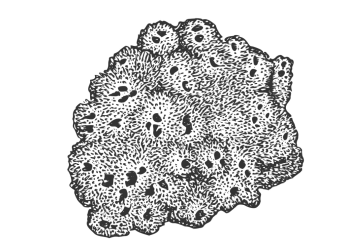 |
| THIS IS NOT HOW EVOLUTION OCCURS!! What this animation implies is that one type of animal became another type of animal. It shows a chimp becoming a human. If so, how come there are still chimps? This suggests direct descent with adaptation and this is a fallacy. What is correct is that the animals shown did all share a common ancestor at some point. |
The first life on Earth is a mystery to us. Our best guess right now states that whatever it was, it showed up about 3.5-3.7 billion years ago. It was a cell, let?s call him Luca (last universal common ancestor). Luca had DNA, or maybe just RNA. He had ways to harness and use energy for his purposes, to adapt to changes in his environment, and to reproduce. Luca possessed all seven of the characteristics of life.
Every living thing you see around you, and all the living things you can?t see around you, are descended from Luca. But here is the part that?s a little harder to understand ? it hasn?t been a straight line from Luca through all other life forms to you.
It?s the difference between common descent and direct descent. Just because humans and pine trees have a common ancestor, it doesn?t mean that we are direct descendents of the same organism.
At some point, about 3.5 billion years ago, archaeal prokaryotes were recognizable. Luca gave rise to archaea and also to bacteria, but we can?t say that bacteria descended directly from archaea. There are as many differences between archaea and bacteria as there are between you and a pine tree, maybe more. All we can say is that they diverged from a common ancestor, which is why they have somecommon characteristics (from a common ancestor), and manydifferent characteristics (because they diverged).
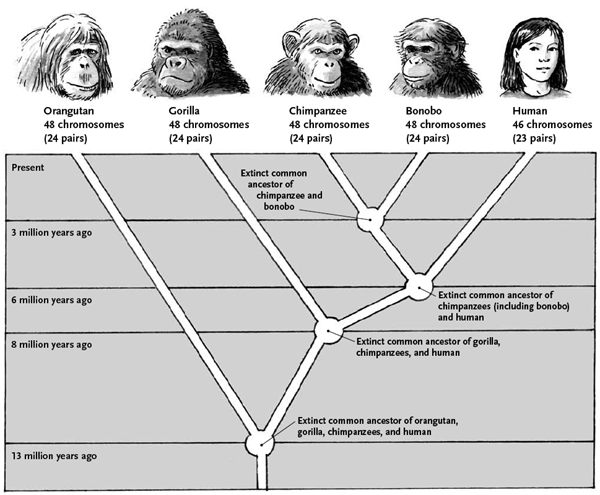 |
| This is a much better representation of evolution through common descent and adaptation. We may not know what exact organism was the last common ancestor between any two branches since only the fossil record only represents about 1% of species that lived. |
Archaea, as opposed to bacteria, diverged again and again, giving rise to the rest of the kingdoms we know today ? protists, plants, fungi, and animals. The question is, why did they diverge so much, while bacteria stayed so much the same?
I don?t know the answer, but a good theory is the development of organelles. We have talked before about how an archaea swallowed a bacteria, but didn?t destroy it, and how that the eukaroytic nucleus. Another instance in this endosymbiosis theoryformed the mitochondrion. The more complex something is, the more chance for it to respond to changes in the environment ? more adaptation could have led to more divergence.
Through billions of years of struggle and adaptation, the eukaryotic kingdoms emerged ? but again, you can?t say that one descended directly from another. Contrast evolution to the alphabet. C follows B, which follows A. Humans like to think linearly. But consider that there may be millions of A?s. Must they all become B?s and then C?s?
No, millions of A?s may breed and remain A?s over the years, while what became a B breeds and stays a B. Maybe later on a couple of A?s breed and have a little baby that looks like neither an A nor a B. Now we have C. B and C or both diverged from A, but B and C are different from one another. They are linked by common, but not direct, descent.
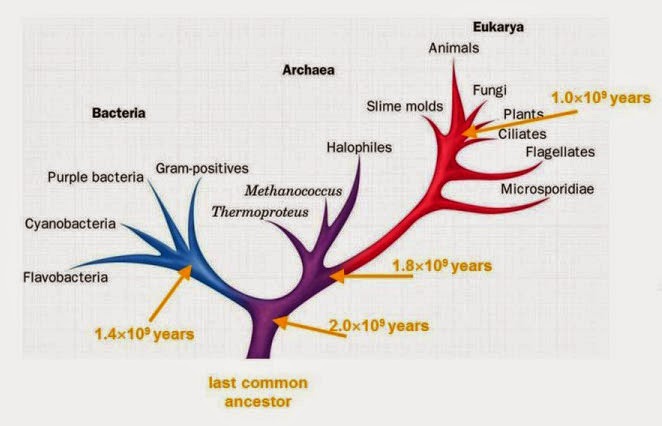 |
| This is a phylogenetic map of the life on Earth. Notice that we don?t know just what the last common ancestor was, but you see that eukaryotes diverged from archaea and that animals, plants, and fungi diverged from protists (microsporidia, flagellates, ciliates, slime molds) rather recently. Trees may look a bit different based on what DNA target gene is being compared. |
A long time ago, a few archaeal descendents had diverged enough to be called protists. They were eukaryotic now, with organelles and special functions, and were starting to think about working together as multicellular organisms. The protists of that timewere direct descendents of archaea, but the different protists we know today (see our last few posts here, here, and here) aren?t necessarily directly descended from one another or even from the same archaea.
Some protists diverged from one another. Many stayed as protists, even though they might have evolved to different orders or families over the years. However, others became animals, fungi, or the plants. Our last common ancestor with plants was a protist of some sort, so we have a common ancestor with a pine tree, we just can?t draw a direct line through humans and a pine tree to get to that ancestor.
Let?s use undulipodia(eukaryotic flagella and cilia) to illustrate, or confuse, the situation. We saw that protists ? most all of the different protists, use flagella or cilia in one or several ways. Flagella and cilia are characteristics that have been retained in the various descendents of archaea?. But didn?t we also say that prokaryotic flagella and eukaryotic undulopdia are completely different in structure and genes? Yes we did - so what gives.
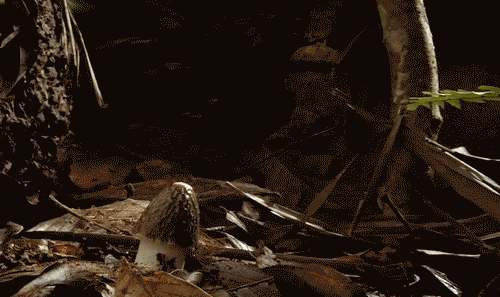 |
| This is a typical fungus that someone might think of. This is the basidiomycete mushroom, Phallus indusiatus. Fungi can range from single cell yeasts (yeah beer!) to hyphal forms that make your tongue fuzzy, to mushrooms that can take up thousands of acres. By the way, in New Guinea they worship P. indusiatus as sacred and that lacy web is called an indusium. |
Yet, if you look for undulipodia in the fungal species on Earth today, you?ll find them in only one of the five phyla. Again, what gives? Didn?t we just say that fungi descended from undulipodia containing ancestors?
Four of the phylums of fungus are grouped by characteristics, both genetic and life cycle ? the Chytridiomycetes, the Zygomycetes, the Ascomycetes and the Basidiomycetes. The fifth phylum is called the imperfect fungi because we haven?t found a life cycle in them that we can place into one of the other four phyla. But when we do, as we have for some individuals imperfect fungi, they usually fall into the ascomycete or basidiomycete phylum.
However, only chytrid fungi have flagella. Every species in every other phylum of fungi has lost their undulipodia. If you are thinking in terms of phylogenetics ? what does this suggest to you?
Yes, very good ? the chytrids are probably the common ancestor for all the other fungi. Those that didn?t diverge enough and stayed chytrids retained their undulipodia, but at some point, others lost their flagella and kept on changing into all the other phyla of fungi over time.
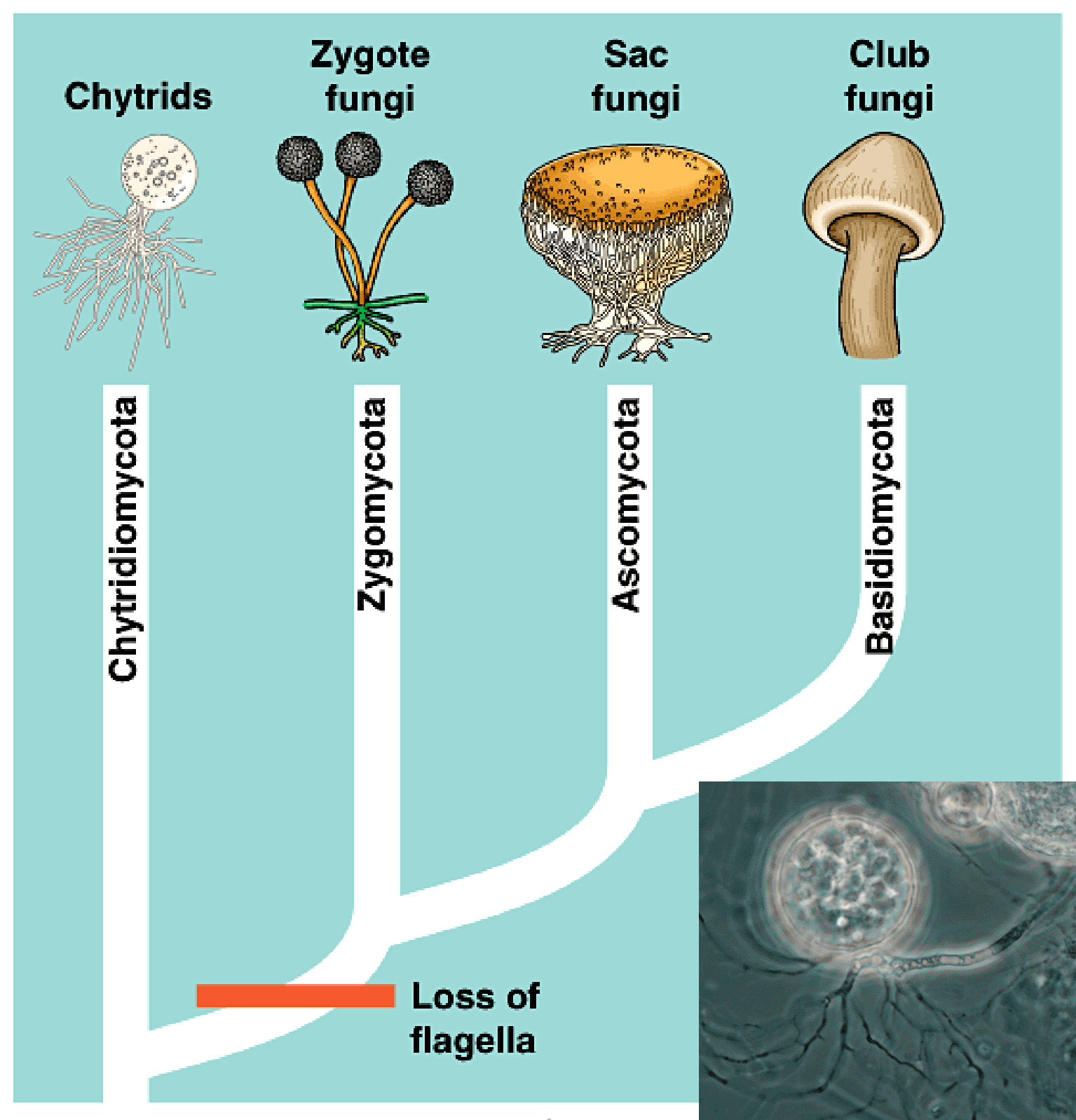 |
| Here is a phylogenetic tree of the fungi, showing that flagella were lost after the other phyla diverged from the Chytridiomycetes. On the bottom right is a microscopic image of the mature sporangium of a chytrid fungus. The zoospores are inside the sporangium. The dark filaments are rhizobia, not flagella. |
What is so different about the chytrids that they kept their flagella, while the others were suited to live without them? There must be something about the chytrids life cycle and/or environment that required the retention of their eukaryotic flagella. Well, they all live in water, maybe they need flagella to swim around. But look at the picture of the chytrid on the right, I don?t see a flagellum anywhere there.
The chytridiomycete name comes from the Greek chytridion, which means little pot. The pot holds all their zoospores, their reproductive form. It is the zoospores that have the flagella, so they can swim away and establish themselves somewhere with less competition. But that isn?t a good enough explanation. Many water borne fungi come from the basidiomycete or ascomycete phyla, and they don?t have flagella in any of their life cycle stages. Hmmm.
We have tens of thousands of extant (living today) fungal species, and only about 750 or so have any undulipodia. This makes the chytrids exceptional, and is directly related to their being the common ancestor for all the other fungi. If undulipodia are so important that animals, protists, some fungi, and even some plants have them, then why is it that so many fungi seem to get along fine without them? Maybe they?re the exception.
Let?s tell one story of how the chytrid flagella are important. A species of chytrid, called Batrachochytrium dendrobatidis,is responsible for perhaps the largest vertebrate mass extinction in the history of the Earth - and it's going on right now. Most chytrids are sabrophyitc, meaning they eat dead tissue, but a few are parasitic, mostly on plants.
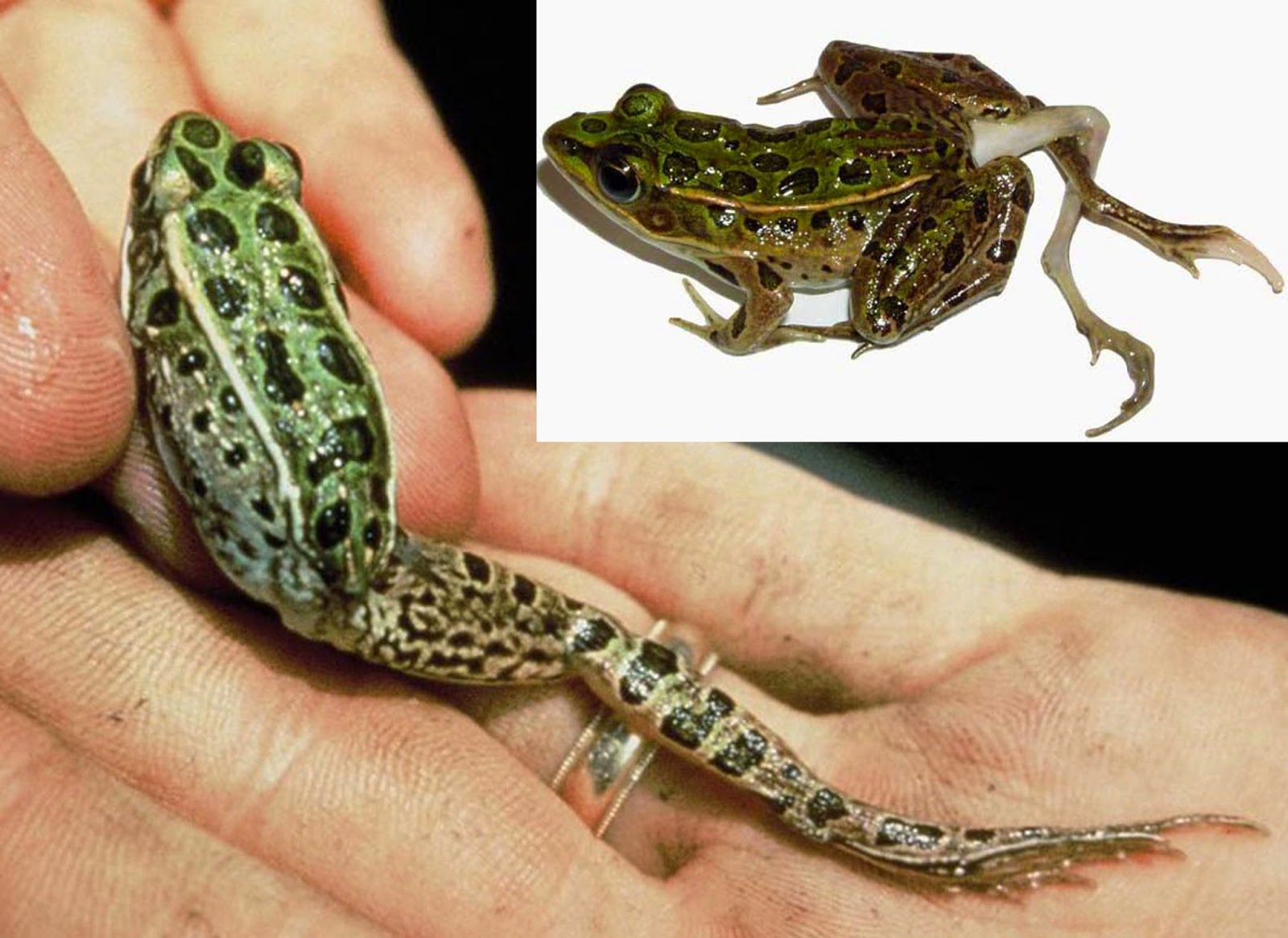 |
| Although the chytrid infection is a large reason for amphibian collapse, there are others. Mutagens in pollution are responsible frogs with extra or missing limbs. You can imagine how that might interfere with long life and mating. It turns out that amphibians, being in and out of water, are especially vulnerable to environmental changes. |
You may have heard of the frightening loss of amphibian diversity on the past decades. The reasons for this are known to be several, including toxic pollutants, climate change, and habitat destruction. But B. dendrobatidis has played a significant role as well. Fortunately, a 2011 study showed that a water flea has a voracious appetite for our frog foe and might be used as a control measure. Unfortunately, a 2013 study showed that chytrid-susceptible amphibians may be succumbing to at least two different, and probably more, species of Batrachohytria. So the problem is probably more complex than we thought.
And yes, you read correctly a couple of paragraphs above. Some plants have cells that have flagella. There are moving plants cells! Those will be our exceptions for next week.
For more information or classroom activities, see:
Common descent ?
http://www.google.com/url?sa=t&rct=j&q=&esrc=s&source=web&cd=2&ved=0CCYQFjAB&url=http%3A%2F%2Fconcord.org%2Fprojects%2Fevolution-readiness%2Fmaterials%2FTeacherGuide_Lego_TXMO_final.pdf&ei=y-WYVJjJKdSAygSGmYKYAw&usg=AFQjCNGksmgyZ7J9n_MEa1vW2fxCjdswJQ&sig2=ghXX0dn-Ma7_LxrMzt5lqA
http://www.google.com/url?sa=t&rct=j&q=&esrc=s&source=web&cd=2&ved=0CCYQFjAB&url=http%3A%2F%2Fconcord.org%2Fprojects%2Fevolution-readiness%2Fmaterials%2FTeacherGuide_Lego_TXMO_final.pdf&ei=y-WYVJjJKdSAygSGmYKYAw&usg=AFQjCNGksmgyZ7J9n_MEa1vW2fxCjdswJQ&sig2=ghXX0dn-Ma7_LxrMzt5lqA
http://www.actionbioscience.org/evolution/poolearticle.html
http://science.howstuffworks.com/life/evolution/last-common-ancestor.htm
http://www.ibtimes.co.uk/four-billion-year-old-mystery-last-universal-common-ancestor-solved-1460866
http://nitro.biosci.arizona.edu/ftdna/TMRCA.html\
http://www.foxnews.com/story/2006/07/05/statisticians-common-ancestor-all-humans-lived-5000-years-ago/
http://www.popsci.com/science/article/2013-08/undefined/science/article/2013-08/new-dates-humanitys-last-common-male-and-female-ancestors
http://www.popsci.com/science/article/2013-08/undefined/science/article/2013-08/new-dates-humanitys-last-common-male-and-female-ancestors\
Fungi ?
http://www.namyco.org/education/k-12.html
http://www.google.com/url?sa=t&rct=j&q=&esrc=s&source=web&cd=3&ved=0CCoQFjAC&url=http%3A%2F%2Fedis.ifas.ufl.edu%2Fpdffiles%2F4h%2F4h31100.pdf&ei=tueYVPCQAoSKyASVyYGYAw&usg=AFQjCNGDJaTrH0B_3d0AU_sAut5lvtspjA&sig2=k0pqaQjqf_wUOj46Qcr81w
http://botit.botany.wisc.edu/toms_fungi/teachers.html
http://science.lotsoflessons.com/fungi.html
https://www.google.com/search?q=animated+gif+fungus&biw=1628&bih=879&source=lnms&sa=X&ei=md-YVLTKD8mBygScj4GgAw&ved=0CAcQ_AUoAA&dpr=1#q=fungi+classroom+activity&start=10
http://www.google.com/url?sa=t&rct=j&q=&esrc=s&source=web&cd=17&ved=0CEIQFjAGOAo&url=http%3A%2F%2Fwww.clarku.edu%2Ffaculty%2Fdhibbett%2FTFTOL%2Flesson%2520plans%2FIntroduction%2520to%2520fungi%2520lesson.doc&ei=MuiYVOCmAYSeyQTo44KgAw&usg=AFQjCNH2neut_mt11ia3Nvr2WALIJYx4Ew&sig2=_NQx6jhXDon5vqQ5V3A5Sg
http://education.nationalgeographic.com/education/media/fungi/?ar_a=1
http://www.ucmp.berkeley.edu/fungi/fungi.html
http://www.kew.org/science-conservation/plants-fungi/fungi/about
http://www.backyardnature.net/f/funclass.htm
Amphibian collapse ?
http://oregonstate.edu/ua/ncs/archives/2011/apr/catastrophic-amphibian-declines-have-multiple-causes-no-simple-solution
http://www.rawstory.com/rs/2013/05/scientists-frog-and-toad-declines-signal-of-collapse-of-the-worlds-ecosystems/
http://sapiens.revues.org/1406
http://www.saczoo.org/page.aspx?pid=408
http://ngm.nationalgeographic.com/2009/04/amphibian/holland-text
http://news.mongabay.com/news-index/amphibian%20crisis1.html
http://phys.org/news/2014-10-amphibian-collapse-viral-outbreak.html
http://www.nbcnews.com/id/42868224/ns/technology_and_science-science/t/fungus-causing-epidemic-among-amphibians/
http://www.cell.com/current-biology/abstract/S0960-9822%2814%2901149-X?cc=y
http://thereptilereport.com/amphibian-collapse/
http://www.scienceworldreport.com/articles/18151/20141017/amphibian-species-collapsing-spain-due-deadly-virus.htm
http://spatialepidemiology.blogspot.com/2014/10/bd-is-not-only-amphibian-pathogen.html
Phylogenetics ?
http://www.hhmi.org/biointeractive/classroom-activities-biodiversity-and-evolutionary-trees
http://evolution.berkeley.edu/evolibrary/article/phylogenetics_01
https://www.youtube.com/watch?v=fQwI90bkJl4
http://www.google.com/url?sa=t&rct=j&q=&esrc=s&source=web&cd=2&ved=0CCUQFjAB&url=http%3A%2F%2Frepository.brynmawr.edu%2Fcgi%2Fviewcontent.cgi%3Farticle%3D1000%26context%3Dbio_pubs&ei=keuYVImZFMOLyASq8IKgAw&usg=AFQjCNEPU18NX8T7nZD2ETEHO8atu55Khg&sig2=T0ypmlpl96N8dlhJWNJMjQ&bvm=bv.82001339,d.aWw
http://www.google.com/url?sa=t&rct=j&q=&esrc=s&source=web&cd=5&ved=0CD0QFjAE&url=http%3A%2F%2Fwww.cse.emory.edu%2Fsciencenet%2Fevolution%2Fteacher%2520projects%2Fwalton.doc&ei=keuYVImZFMOLyASq8IKgAw&usg=AFQjCNEorXNTfFr8l3Y9JTSoMTVdy3KHMg&sig2=NkNQ9sLhtpMeiCacEjpnGw&bvm=bv.82001339,d.aWw
http://www.indiana.edu/~ensiweb/lessons/mol.bio.html
http://evolution.berkeley.edu/evolibrary/article/evo_10
http://serc.carleton.edu/sp/merlot/biology/interactive/examples/12431.html
http://www.pbs.org/wgbh/nova/education/activities/2905_link.html
http://education-portal.com/academy/lesson/cladograms-and-phylogenic-trees-evolution-classifiations.html
http://evoled.dbs.umt.edu/lessons/pathways.htm
- Unifying Themes In Biology
this will be built on heavily as posting progresses. These unifying ideas should help to make it so that the interconnectivity of biology is clearer, so while learning, questions like "what is this all for/why is it important?" can be answered. 1. Emergent...
- 4/2/14
Today Mrs.Tyrell was back from being sick. Then we discussed more about eubacteria and archaebacteria. Also, about the nasty flesh eating bacteria that eats your flesh. Then we took notes more about Fungi. Hyphae has thread like structure and it's...
- Orgin Of Eukaryotes
News feature article on the Orgin of Eukaryotes Cells BREAKING NEWS: We have discovered the ancestors of the eukaryote cells. The Eukaryotic cells wasn't the earliest form of cell, but originated from it's ancestor the prokaryotic cells. There...
- Almost This Or Almost That? Must Be The Other
Biology concepts ? Protista, taxonomy, phylum, kingdom, monophyletic, paraphyletic, cladistics, algae, diatom, dinoflagellate Euglena gracilis is an organism in the Kingdom Protista. It has one long flagellar undulipodium, but it can also move by...
- One Thing Is Just Like The Other ? Sort Of
Biology concepts ? undulipodia, convergent evolution, parallel evolution, homologous structures, re-emergent evolution, atavism, flagella, eukaryote, prokaryote This represents the evolution of cell phones over the last couple of decades. The latest...
